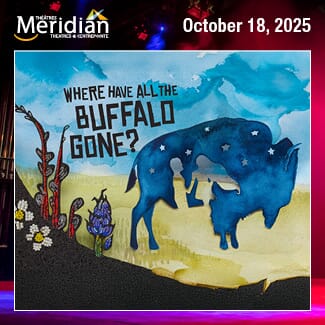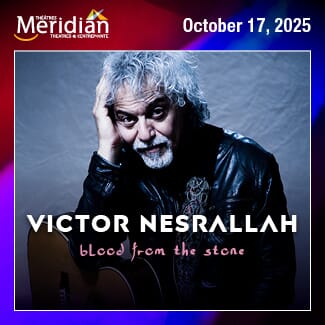After a nearly year-long hiatus, Opera Lyra Ottawa returns to the stage of Southam Hall at the National Arts Centre with a limited-engagement production of La Bohème, in the hopes of rekindling their fortunes. I think they stand a rather good chance of succeeding, and winning the hearts of new audience members to boot.
The plot of Puccini’s La Bohème is simple enough: Rodolfo (Michael Fabiano) is a poet who lives in a Parisian garret (an attic) with the painter Marcello (Joshua Hopkins), the musician Schaunard (Peter McGillivray), and philosopher Colline (Valerian Ruminski). On Christmas Eve, they are reduced to keeping themselves warm by burning the manuscript of Rodolfo’s play, until Schaunard shows up with unexpected cash. They deftly avoid paying it all in rent to their landlord Benoît (Peter Strummer) and head out to spend their money in the streets of the Latin Quarter. Rodolfo, staying behind to finish some work, has a chance encounter with a seamstress, Mimì (Joyce El-Khoury), with whom he instantly falls in love. They join Rodolfo’s roommates for a night on the town, which is interrupted by Marcello’s on-again-off-again girlfriend Musetta (Laura Whalen) and her (successful) attempts to inflame Marcello’s jealousy. As in any romance, there would be no story were there not something to keep lovers apart; in the case of Marcello and Musetta it is their equally passionate temperaments, while in the case of Rodolfo and Mimì it is the more serious effects of poverty that will ultimately divide them.
(The opera is sung in the original Italian, so English and French surtitles are projected for the benefit of the audience. I read both; the French, of course, is closer to the Italian both in meaning and specific idiom, but there is nothing significant lost in either version.)
Opera Lyra has assembled an exceptional cast in terms of vocal talent, stage presence, suitability to their roles, and suitability to each other. Tenor Michael Fabiano has mesmerizing stage presence, and a powerful, clear voice. He and baritone Joshua Hopkins play especially well against one another, and a real feeling of camaraderie between their characters and those of Peter McGillivray and Valerian Ruminski comes across throughout the performance. Laura Whalen renders Musetta with charm, wit, and a sense of humour. Valerian Ruminski has an exceptionally rich, crisp bass that comes to the fore in the final act. Peter Strummer handles two different comic roles so expertly that you do have to check the program to verify that they are indeed the same person. And, of course, hometown soprano Joyce El-Khoury is a rising star whose talent and vocal nuance are well worth experiencing in the flesh.
Their unaided voices—there is no (ghastly) amplification in opera—soar over the NAC orchestra, seamlessly conducted by Alexander Shelley, to fill the theatre; they are matched by Joe Bascetta’s immense yet sparing stage design. The change of scene between Acts I and II, performed in full view of the audience (there are four acts; the two intermissions, between Acts II and III and Acts III and IV, are more than sufficient), highlights the versatility of what, on the surface, seems to be a fairly simple set. The garret-window backdrop features a Paris skyline silhouette across its base; combined with Claude Accolas’s lighting design it serves to convey the mood and the passage of time remarkably well. The final tableau, just before the curtain falls, is so breathtaking that it ought to be a painting; it is difficult to imagine someone not being emotionally moved in that moment.
La Bohème speaks (sings, rather) of a particular time and place, yet it is not a stretch to imagine it taking place in a variety of different settings. Baz Luhrmann found it transposed quite well to 1957, and one can imagine Rodolfo as a freelance writer (perhaps even a blogger), Marcello as a graphic designer, and so forth (maybe Mimì has an Etsy shop?), occupying a walk-up in Williamsburg—or Hintonburg—and living out the same bohemian lifestyle with the same disdain for the bourgeois patrons of their local restaurants and cafés. La Bohème has endured, and will continue to endure, because of its fundamental beauty; but it remains accessible because, even through the extreme stylization of opera, the characters are unequivocally real.
Opera and theatre are two entirely different beasts. In opera, the musical aspect of the performance is of at least equal importance to the dramatic aspect, and in most cases of greater importance. The criteria by which one evaluates opera, are consequently more broad than those that apply to theatre. Yet, precisely because opera is so complex, and there are so many aspects of it at work simultaneously contributing to the experience, it seems to attract a greater audience. Scarcity may be a factor in this; if we had twenty-four local opera productions a year the audience base, not to mention their wallets, might be stretched quite thin.
If you enjoy opera and are thirsting for a live, local, professional production, I imagine you already have your tickets to La Bohème, as you ought to. Those for whom the opera is an unknown quantity will find it at the very least a pleasant experience, and are liable to discover a love for it. If you are at all curious about opera, this is definitely the perfect opportunity to experience what it has to offer. I don’t think there’s any way Opera Lyra could fail to mostly fill the house for all four evenings of this production. Bravi tutti!
Opera Lyra’s La Bohème plays tonight, the 10th, the 12th and the 15th. Tickets are available through the NAC box office or through Ticketmaster.













